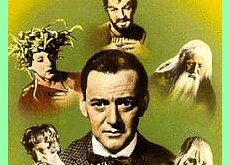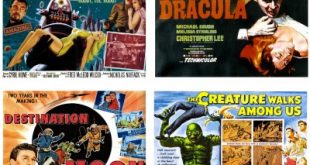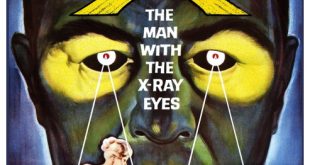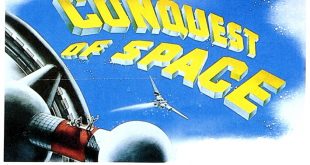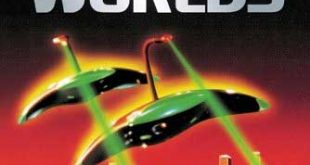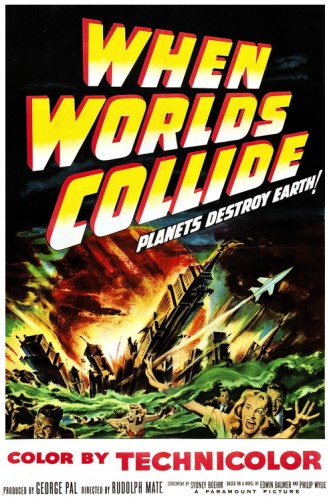 SYNOPSIS:
SYNOPSIS:
“David Randall is a carefree ladies man and skilled pilot who finds he has been let in on the greatest and most terrible secret in the world when he is paid to deliver some mysterious pictures from one eminent astronomer to another. The recipient, Doctor Hendron, confirms the awful findings of the sender: the star Bellus will collide with Earth and wipe out all of humanity. Despite widespread disbelief, two philanthropists give Doctor Hendron some of the money he needs to build a rocket ship that will, at least theoretically, take them to Zyra, a planet which is orbiting Bellus which may or may not be habitable for humans. The rest of the money comes from Sydney Stanton, a wheelchair-bound old man, who insists he come along, despite the severe limitations on the number of passengers and amount of cargo. Meanwhile, as doomsday approaches, Randall is surprised to find himself in a love triangle with Doctor Hendron’s daughter and her fiancé. Humanity is in peril, and only a modern-day Noah’s ark, and the continued need of a man for a woman, can save it.” (courtesy IMDB)
REVIEW:
George Pal is the filmmaker most associated with Hollywood science fiction films during the fifties, but he never really seemed to grasp what science fiction was all about. His main interest seemed to be in pure fantasy. Prior to his first feature film – The Great Rupert (1949) concerning a unique stop-motion animated squirrel – he had made his name with a series of short films called Puppetoons featuring puppets animated by stop-motion photography. He shrewdly jumped onto the science fiction bandwagon before most other Hollywood producers even knew there was one, and his background in special effects ensured that his films were at least spectacular in that area, but his inability to choose good scripts was a serious handicap which persisted right through to the seventies, as the misguided Doc Savage (1975) written by Lorenzo Semple Junior demonstrates. Pal’s early films, though considered lavish epics at the time, were actually made on fairly modest budgets, even for those days. Skilled use of special effects and various economic shortcuts allowed them to appear quite spectacular.
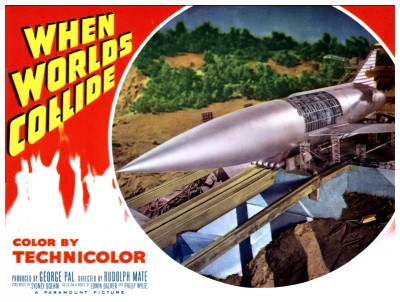 That filmmakers suddenly became interested in ways of leaving the Earth during the fifties is not surprising since, at the time, it didn’t seem likely that the Earth would be around for very much longer. But in true Hollywood fashion, filmmakers preferred not to face the threat of atomic war head-on but to reflect it indirectly. Instead of showing us what might actually happen during an atomic war, the bomb was represented by various euphemisms such as giant beasts, activated by atomic radiation, that rise out of the sea and trample down cities. Films like The War Of The Worlds (1953) and When Worlds Collide (1951) are also indirect reflections of a reality too awful to contemplate – in the former the world is almost destroyed not by atomic warfare but an omnipotent force from Mars, and in the latter by collision with another planet.
That filmmakers suddenly became interested in ways of leaving the Earth during the fifties is not surprising since, at the time, it didn’t seem likely that the Earth would be around for very much longer. But in true Hollywood fashion, filmmakers preferred not to face the threat of atomic war head-on but to reflect it indirectly. Instead of showing us what might actually happen during an atomic war, the bomb was represented by various euphemisms such as giant beasts, activated by atomic radiation, that rise out of the sea and trample down cities. Films like The War Of The Worlds (1953) and When Worlds Collide (1951) are also indirect reflections of a reality too awful to contemplate – in the former the world is almost destroyed not by atomic warfare but an omnipotent force from Mars, and in the latter by collision with another planet.
 With few exceptions, humans are presented very badly in these films. No sooner is there a whiff of impending doom than the average citizen reverts to a cowardly, greedy, selfish, lustful animal. This was particularly so in When Worlds Collide which, though it ends on an optimistic note, suggests that whatever catastrophe may befall mankind will be well and truly deserved. Though often threatened with total destruction, the world rarely experienced such a fate in science fiction films of the fifties, but one exception was When Worlds Collide, directed by Rudolph Maté, the Polish-born ex-cameraman whose film career had begun back in the silent era and famously photographed such dark films as Carl Dreyer‘s Vampyr (1932). Based on the novel by Edwin Balmer and Philip Wylie, it had originally been purchased by Paramount Pictures for Cecil B. DeMille and, since it’s basically a modern biblical epic, one can see why.
With few exceptions, humans are presented very badly in these films. No sooner is there a whiff of impending doom than the average citizen reverts to a cowardly, greedy, selfish, lustful animal. This was particularly so in When Worlds Collide which, though it ends on an optimistic note, suggests that whatever catastrophe may befall mankind will be well and truly deserved. Though often threatened with total destruction, the world rarely experienced such a fate in science fiction films of the fifties, but one exception was When Worlds Collide, directed by Rudolph Maté, the Polish-born ex-cameraman whose film career had begun back in the silent era and famously photographed such dark films as Carl Dreyer‘s Vampyr (1932). Based on the novel by Edwin Balmer and Philip Wylie, it had originally been purchased by Paramount Pictures for Cecil B. DeMille and, since it’s basically a modern biblical epic, one can see why.
 In Pal’s version, with a screenplay written by Sydney Boehm, the film begins with the pilot Dave Randall (Richard Derr) being assigned to fly a set of photographic plates from a South American observatory to one in the United States. The photographs reveal that a wandering star called Bellus, accompanied by its captive planet Zyra, has entered the solar system and will eventually collide with the Earth. The world is doomed, but a small portion of humanity has a chance of survival, according to scientist Doctor Hendron (Larry Keating) who had designed a spaceship capable of reaching Zyra, which appears to be habitable. The building of the spaceship, as in Pal’s Destination Moon (1950), is achieved by private enterprise (an idea that seemed laughable until Richard Branson came along). In this particular case the money is being provided by an unpleasant wheelchair-bound billionaire called Stanton (John Hoyt) whose reasons are purely selfish.
In Pal’s version, with a screenplay written by Sydney Boehm, the film begins with the pilot Dave Randall (Richard Derr) being assigned to fly a set of photographic plates from a South American observatory to one in the United States. The photographs reveal that a wandering star called Bellus, accompanied by its captive planet Zyra, has entered the solar system and will eventually collide with the Earth. The world is doomed, but a small portion of humanity has a chance of survival, according to scientist Doctor Hendron (Larry Keating) who had designed a spaceship capable of reaching Zyra, which appears to be habitable. The building of the spaceship, as in Pal’s Destination Moon (1950), is achieved by private enterprise (an idea that seemed laughable until Richard Branson came along). In this particular case the money is being provided by an unpleasant wheelchair-bound billionaire called Stanton (John Hoyt) whose reasons are purely selfish.
 A nationwide lottery is organised to determine who should have the opportunity to escape destruction (room for only forty young people capable of breeding being eligible, with the exception of industrialist Stanton) and those who don’t get a winning number quickly give way to despair. There are outbreaks of rioting and riotous living as the rogue star approaches, bringing with it earthquakes and floods. Tension mounts as the collision day draws near and, of course, once the ship is completed, in the nick of time, new obstacles occur prior to launch, including a revolt by those workers being left behind. The take-off proves successful and, despite the strains of acceleration, the ship’s passengers survive to reach Zyra some hours later, their journey punctuated by the sight of Bellus colliding with the Earth on the ship’s monitor screens. The film ends with humanity’s representatives – the new Adams and Eves – stepping off the ship to face a new world that looks like a very big colourful painting – which is exactly what it was.
A nationwide lottery is organised to determine who should have the opportunity to escape destruction (room for only forty young people capable of breeding being eligible, with the exception of industrialist Stanton) and those who don’t get a winning number quickly give way to despair. There are outbreaks of rioting and riotous living as the rogue star approaches, bringing with it earthquakes and floods. Tension mounts as the collision day draws near and, of course, once the ship is completed, in the nick of time, new obstacles occur prior to launch, including a revolt by those workers being left behind. The take-off proves successful and, despite the strains of acceleration, the ship’s passengers survive to reach Zyra some hours later, their journey punctuated by the sight of Bellus colliding with the Earth on the ship’s monitor screens. The film ends with humanity’s representatives – the new Adams and Eves – stepping off the ship to face a new world that looks like a very big colourful painting – which is exactly what it was.
 This type of romantic melodrama with the trappings of technology harkens back to films like Fritz Lang‘s Woman On The Moon (1929), as well as the apocalyptic destruction of Abel Gance‘s End Of The World (1930) and Felix Feist‘s Deluge (1933). It indulges in utopian longings that science as the new savior can lead mankind to idealistic worlds far removed from the materialism of a dying Earth. This is unambiguously presented in the film’s opening quotation from the book of Genesis recounting how God was determined to destroy the world because of humanity’s wickedness, and concludes with a title in Gothic font: “The first day on the new world had begun…” accompanied by an orchestra, angelic voices and chiming church bells. In other words, science has usurped the role of Creator. Zyra emerges as the contemporary Eden, a bucolic environment that the early fifties chose to fantasise about amid the escalating menace of atomic obliteration.
This type of romantic melodrama with the trappings of technology harkens back to films like Fritz Lang‘s Woman On The Moon (1929), as well as the apocalyptic destruction of Abel Gance‘s End Of The World (1930) and Felix Feist‘s Deluge (1933). It indulges in utopian longings that science as the new savior can lead mankind to idealistic worlds far removed from the materialism of a dying Earth. This is unambiguously presented in the film’s opening quotation from the book of Genesis recounting how God was determined to destroy the world because of humanity’s wickedness, and concludes with a title in Gothic font: “The first day on the new world had begun…” accompanied by an orchestra, angelic voices and chiming church bells. In other words, science has usurped the role of Creator. Zyra emerges as the contemporary Eden, a bucolic environment that the early fifties chose to fantasise about amid the escalating menace of atomic obliteration.
 Made during the Cold War, When Worlds Collide mirrored a period that spawned curiosity in science fiction because of the space-age technological rivalry between America and Russia. This competition generated a mood of paranoia engendered by the fear of nuclear proliferation and fathered several sub-genres within science fiction – the atomic bomb, its aftermath and the end of the world. According to the writings of Susan Sontag, the film is suffused with the aesthetics of destruction, conflating old monster movies with the depiction of urban disaster on a colossally magnified scale. In the film, Earth’s collision with Bellus (derived from the Latin word ‘Bellum’ meaning ‘War’) becomes a metaphor for the possible atomic annihilation these super-powers can generate.
Made during the Cold War, When Worlds Collide mirrored a period that spawned curiosity in science fiction because of the space-age technological rivalry between America and Russia. This competition generated a mood of paranoia engendered by the fear of nuclear proliferation and fathered several sub-genres within science fiction – the atomic bomb, its aftermath and the end of the world. According to the writings of Susan Sontag, the film is suffused with the aesthetics of destruction, conflating old monster movies with the depiction of urban disaster on a colossally magnified scale. In the film, Earth’s collision with Bellus (derived from the Latin word ‘Bellum’ meaning ‘War’) becomes a metaphor for the possible atomic annihilation these super-powers can generate.
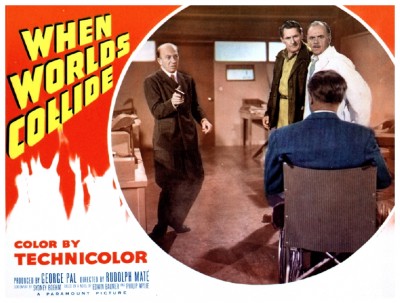 The rocketship itself was designed by respected space artist Chesley Bonestell with the emphasis on realism, and Gordon Jennings and his team of special effects experts justifiably won an Oscar for their work on When Worlds Collide – the model work showing the space-ark taking off and the flooding of New York were of a very high standard. But strangely enough, the event that gives the film its title is never really shown – we never see the worlds actually collide. We see the passengers watching the collision but we the audience are not allowed to witness the sight. And it’s with this final observation – or non-observation as the case might be – we painfully crawl across the finish line of another review. Please try to come back next week – on time – for more cinematic smegma than you can poke a pointed stick at on…Horror News! Toodles!
The rocketship itself was designed by respected space artist Chesley Bonestell with the emphasis on realism, and Gordon Jennings and his team of special effects experts justifiably won an Oscar for their work on When Worlds Collide – the model work showing the space-ark taking off and the flooding of New York were of a very high standard. But strangely enough, the event that gives the film its title is never really shown – we never see the worlds actually collide. We see the passengers watching the collision but we the audience are not allowed to witness the sight. And it’s with this final observation – or non-observation as the case might be – we painfully crawl across the finish line of another review. Please try to come back next week – on time – for more cinematic smegma than you can poke a pointed stick at on…Horror News! Toodles!
 Horror News | HNN Official Site | Horror Movies,Trailers, Reviews
Horror News | HNN Official Site | Horror Movies,Trailers, Reviews

